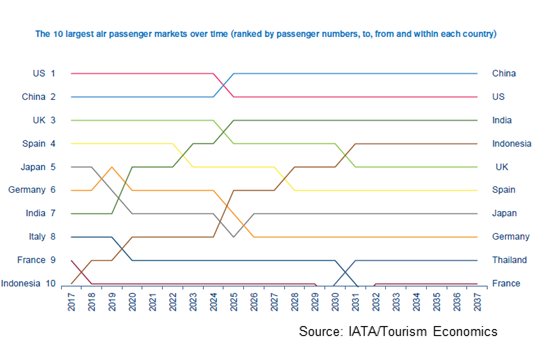A global approach to local airport capacity management
Philip Ireland, IATA's manager for World Wide Airport Slots, explains how the strategic review of the slot guidelines is aiming to improve access despite airport congestion. He says: "It is vital consistent and reliable slot coordination is achieved no matter where the airport is located. Every route has an airport at both ends, and some 54 percent of the global 58,000 routes today have a congested airport at one end."

Posted
Increasing airport congestion at airports across Asia is threatening the ability of airlines to meet consumer demand. It is well documented that the global airline industry is forecast to double in size over the next 20 years, but the challenges to achieve this are particularly apparent in the Asia Pacific region.
According to IATA statistics, by 2031, the top five global passenger markets will include China, India and Indonesia. Ensuring adequate airport infrastructure is being built to meet demand is vital.

The Worldwide Slot Guidelines (WSG) provides the industry with best practice guidance to ensure the most efficient use of airport infrastructure, while balancing the needs of airlines, airports and the consumer. WSG airport slot allocation principles are already in place at 39 of the most congested airports in Asia Pacific. The principles of the WSG facilitate a process that is adopted locally but aligned globally to promote access and competition, connectivity and the establishment of new routes.
Today 43 percent of global passengers are departing from a slot constrained airport, and with just over 200 coordinated airports worldwide this means airlines need to find solutions to meet demand when airport capacity is not readily available.
The slot process is the backbone to the airlines’ planning and operations at these highly demanded, but congested airports, enabling them to sell tickets up to a year in advance and plan growth and investment in the industry.
Although the WSG cannot replace the need for more airport infrastructure, it continues to provide a single standard essential for the global aviation industry. It is regularly reviewed and updated and is currently going through a revision process to ensure it is fit for the next ten-20 years to support the airlines and airports make best use of limited capacity whilst allowing them to grow their businesses to meet demand.
To achieve this, the aviation community agreed to establish an in-depth review of the slot guidelines, including the airport community, the airlines and the slot coordinators, to ensure that all stakeholders contribute and continue to benefit from one global process.
Four task forces were created involving more than 80 aviation professionals who nominated themselves to work together to enhance the WSG, comprising of 25 airlines, including low cost, leisure and cargo carriers, 16 airports and 17 slot coordinator organisations, representing different regions and business models from around the world.
The work is focusing on all aspects of the guidelines, including monitoring slot performance and guidance on this essential coordinator activity, how better to manage the airport levels and how they’re declared, as well as reviewing the elements essential to retaining historic slots.
Reviewing the process for initial allocation of slots is underway to ensure the WSG can continue to promote competition and access at coordinated airports. This work is being carried out by the Access to Congested Airports Task Force. The outcomes of this work should define a new entrant rule which continues to ensure 50 percent of available capacity is offered to airlines that have no or limited current operations at the specific airport, with ability to therefore gain access and grow to compete with existing carriers.
This ensures existing and new airlines have an opportunity to develop new routes and services, in a fair and competitive manner even where capacity is limited. As HK Express noted, these rules are essential when looking to enter, expand and provide a reliable service at slot coordinated airports.
This review of rules for access to congested airports will deliver recommendations for changes early this year, hopefully allowing the WSG to be updated and the enhanced principles adopted by industry for 2020 coordination implementation. Importantly, all enhancements continue to maintain fair, transparent and equal access for all airlines, and will be applicable globally.
The resulting proposals and changes to the WSG from the task forces ensure that the global slot allocation standard remains relevant and best able to meet the increasing challenges of insufficient airport capacity. Without a globally harmonised approach it is almost impossible to achieve certainty between one season to the next – and this is the basis of all airline business planning when it comes to growth in existing markets, and the ability to plan new flights to more destinations.
The success of this airport, airline and coordinator collaboration is evident through the publication of the ninth edition of the WSG, which was effective 1 January 2019. The new edition includes minimum standards for publication of coordination data after the initial slot allocation date helping airports and airlines plan optimisation of routes and their schedule, and enhancements to the demand and capacity analysis process.
Airports, airlines and coordinators also agreed to perform a trial of an earlier slot return deadline, to assess its feasibility and the potential benefits it can bring to the slot planning process. It’s envisaged this could provide more slot churn earlier in the process as well as provide more certainty to the airport operator of the seasons planned schedule.
The current program of work of the task forces includes further enhancements of the WSG by introducing provisions to providing coordinators with information about airlines’ and airports’ business priorities and development plans. Additional improvements of the WSG will include a new section on slot performance monitoring and a section on airport capacity declaration process. In addition to this the task forces are working on delivering additional changes in the WSG by the end of 2019.
But having the guidelines is not enough, they need to be adopted by governments as the basis for airport capacity management when demand outstrips infrastructure. The success of the guidelines to enable growth, promote access and competition, and deliver connectivity benefits at the world’s busiest airports is through the consistent adoption by all.
It is vital consistent and reliable slot coordination is achieved no matter where the airport is located. Every route has an airport at both ends, and some 54 percent of the global 58,000 routes today have a congested airport at one end. The consistent adoption of the WSG will help to sustain the industry in the short term, while the challenge to develop airport infrastructure is met.
